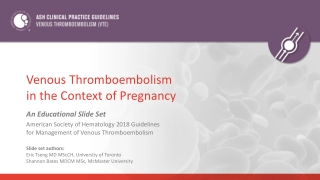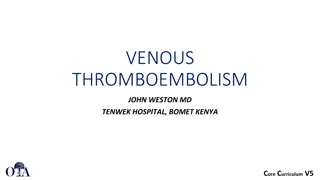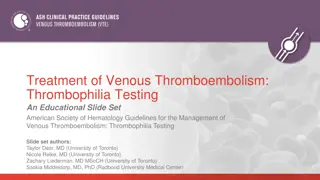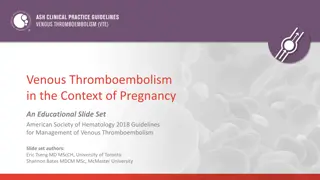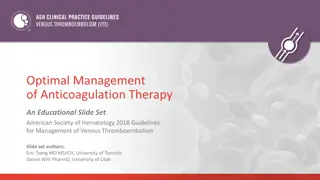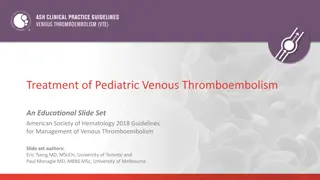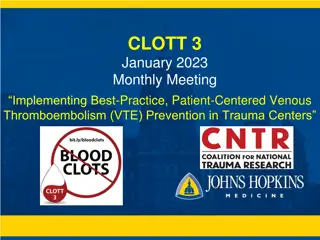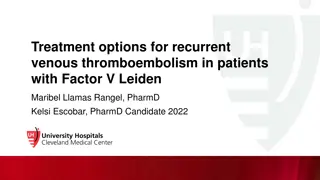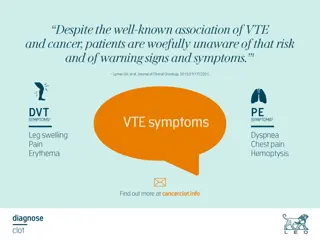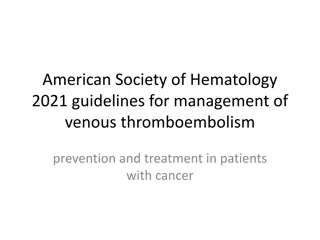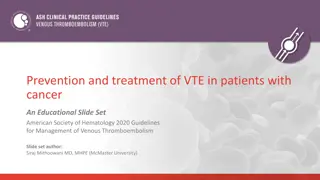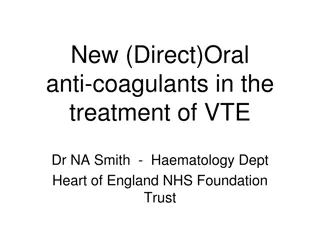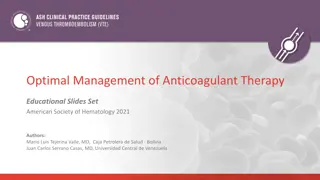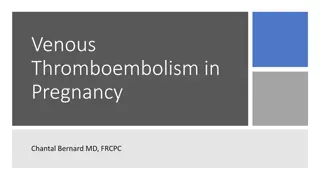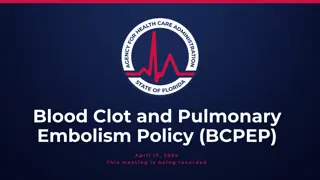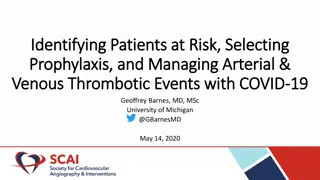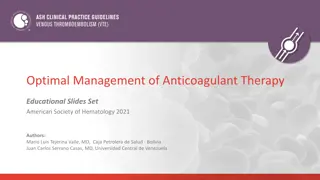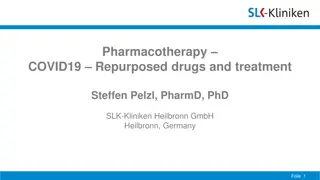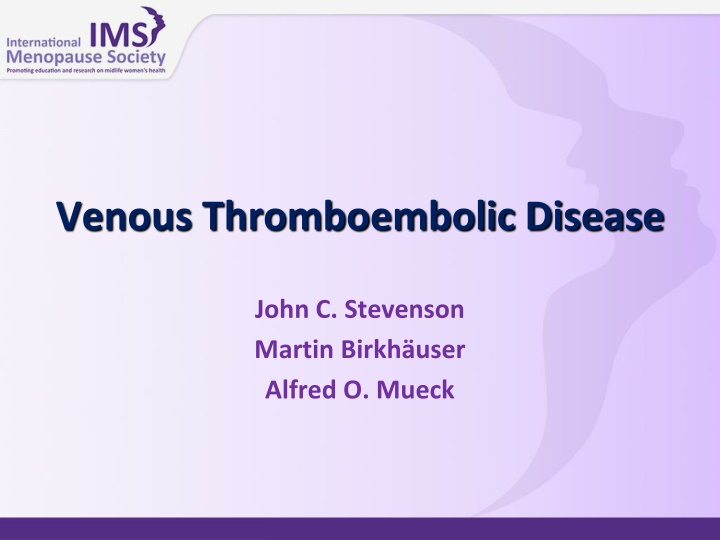
Venous Thromboembolic Disease Risk Factors and Management
Explore the risk factors, absolute risks, and management guidelines for venous thromboembolic disease in postmenopausal women. Learn about the impact of menopausal hormone therapy on thromboembolic risk and the latest research findings on VTE in women's health.
Uploaded on | 2 Views
Download Presentation

Please find below an Image/Link to download the presentation.
The content on the website is provided AS IS for your information and personal use only. It may not be sold, licensed, or shared on other websites without obtaining consent from the author. If you encounter any issues during the download, it is possible that the publisher has removed the file from their server.
You are allowed to download the files provided on this website for personal or commercial use, subject to the condition that they are used lawfully. All files are the property of their respective owners.
The content on the website is provided AS IS for your information and personal use only. It may not be sold, licensed, or shared on other websites without obtaining consent from the author.
E N D
Presentation Transcript
Venous Thromboembolic Disease John C. Stevenson Martin Birkh user Alfred O. Mueck
Venous Thromboembolic Disease 1. Risk factors, absolute risks 2. MHT WHI, RCTs 3. MHT Observational Studies 4. Tibolone, SERMs 5. Experimental Research Thrombophilia, Screening? 6. VTE Management Guidelines, Consensus Statement
Venous Thromboembolic Disease 1. Risk factors, absolute risks 2. MHT WHI, RCTs 3. MHT Observational Studies 4. Tibolone, SERMs 5. Experimental Research Thrombophilia, Screening? 6. VTE Management Guidelines, Consensus Statement
Risk factors for Venous Thromboembolism Age Obesity Malignancy Immobilization History/family history Thrombophilia (Varicose veins) Smoking Oral MHT, specific SERMS Others (e.g. corticoids, intestinal inflammation etc.)
Venous Thromboembolism Risk of VTE in postmenopausal women: 1 per 10,000 patient-years 2 3 non-fatal VTE per year for every 10,000 women given HRT Deaths from VTE: 1 per 1,000,000 patient- years
MHT and thromboembolic risk: Excessive absolute risk A peroral MHT increases moderately the thromboembolic risk, higher risk in presence of hereditary or acquired thrombophilia, and during the first year after initiation of MHT (Age 50 59: 2 additional cases/year per 10,000 women) Low-dose transdermal MHT seems not to increase the thromboembolic risk
Venous Thromboembolic Disease 1. Risk factors, absolute risks 2. MHT WHI, RCTs 3. MHT Observational Studies 4. Tibolone, SERMs 5. Experimental Research Thrombophilia, Screening? 6. VTE Management Guidelines, Consensus Statement
Health outcomes in the overall study population in WHI during the intervention phase final results (2013) Manson JE et al. JAMA. 2013;310:1353-1368.
WHI: Incidence of VTE stratified by age (combined arm, n = 16,608 women) Age (years) 50 59 60 69 70 79 Placebo E + P Placebo E + P Placebo E + P Number of cases 13 32 38 76 25 60 Annualized rate 0.8 1.9 1.9 3.5 2.7 6.2 (1000 person-years) Hazard ratio 1.0 95% CI (1.2 4.3) (1.2 4.4) (2.4 7.7) (1.7 6.6) (4.3 14.4) 2.27 2.31 4.28 3.37 7.46 Cushman M et al JAMA 2004;292:1573 80
WHI: BMI as risk factor for VTE (combined arm, n = 16,608 women) Body mass index < 25 25 30 > 30 Placebo E + P Placebo E + P Placebo E + P Number of cases Annualized rate 0.9 1.6 1.5 3.5 2.5 5.1 (1000 person-years) 13 24 24 59 38 83 Hazard ratio 1.0 1.8 95% CI 1.6 3.8 2.8 5.6 (0.9 3.5) (0.8 3.2) (2.1 6.9) (1.5 5.4) (3.1 10.1) Cushman M et al JAMA 2004;292:1573 80
Venous Thromboembolic Disease 1. Risk factors, absolute risks 2. MHT WHI, RCTs 3. MHT Observational Studies 4. Tibolone, SERMs 5. Experimental Research Thrombophilia, Screening? 6. VTE Management Guidelines, Consensus Statement
Randomized clinical trials (RCTs) - Risk of VTE HERS (1998) RR 2.9 (CI 1.5 5.6) RR 1.3 (CI 1.0 1.8) RR 2.1 (CI 1.6 2.7) RR 7.5 WHI (E alone) (2004) WHI (E + P) (2004) E + P (age 70 79 years) vs. placebo (age 50 59 years) E + P (age 50 59 years) vs. placebo (age 70 79 years) RR 0.7 DOPS (2012) RR 2.0 (CI 0.2-22.2) Hulley et al. J Am Med Assoc 1998;280:605 13 Cushman et al. J Am Med Assoc 2004;292:1573 80 Women s Health Initiative Steering Committee. J Am Med Assoc 2004;291:1701 12 Schierbeck LL et al. Ann Intern Med 2012;157:104-13
Oral MHT and VTE Observational studies Case-control studies (n = 7) RR 2.1 (CI 1.4 3.0) Prospective cohort studies (n = 1) RR 2.1 (CI 1.2 3.8) Oger and Scarabin. Drugs Aging 1999;14:55 61
Oral MHT and VTE Duration and dose of HRT Risk of VTE higher in first year of treatment <1 year Duration >1 year Risk of VTE dose- dependent High Dose Effect of MHT less than OC in women with other increased VTE risk Low 0 2 4 6 8 Odds ratio Oger and Scarabin. Drugs Aging 1999;14:55 61, Waselenko et al. Semin Thromb Hemost 1998;24(Suppl):33 9
Observational studies comparing oral vs. transdermal MHT ESTHER Scarabin PY et al., Lancet 2003; 362: 428-432 E3N Canonico M et al Arterioscl Thromb Vasc Biol 2010; 30: 340-345 GPRD Renoux C et al. J Thromb Haemostasis 2010: 8: 979-986 Longitudinal Population Ohira T et al. Br J Haematol 2010; 149: 606-612 Million Women Study Sweetland S et al. J Thromb Haemost. 2012 Sep 10. doi: 10.1111/j.1538-36.2012.04919.x. Metaanalysis Canonico M et al. Br Med J 2008 , 336: 1227-1231
Risk of VTE: oral vs transdermal MHT (ESTHER Case/Control-Study) No MHT Transdermal MHT Oral MHT 0 2 4 6 8 Odds ratio Scarabin, et al. Lancet 2003;362:428 32
Risk of VTE: oral vs transdermal MHT (E3N French Cohort Study) Increased risk (vs. never-users) with oral estrogen RR: 1.7; 95% CI: 1.1 2.8 No increased risk (vs. never-users) with transdermal estrogen RR: 1.1; 0.8 1.8 Increased risk for oral vs. transdermal estrogen users RR: 1.5; 1.1 2.0 Canonico M et al. Arterioscler Thromb Vasc Biol 2010;30:340 5
Risk of VTE: oral vs transdermal MHT (Nested Case-Control study from the UK General Practice Research Database) Risk not increased (vs. non-use) with: Transdermal estrogen alone: RR 1.01 (95% CI: 0.89 1.16) Transdermal estrogen + progestogen: RR 0.96 (0.77 1.20) Risk increased (vs. non-use) with: Oral estrogen: RR 1.49 (1.37 1.63) Oral estrogen-progestogen: RR 1.54 (1.44 1.65) Risk increased with higher estrogen doses Renoux C et al. J Thromb Haemost 2010;8:979 86
Risk of VTE: Dependency on the progestogen component (ESTHER Case/Control study) Route/progestagen OR 95% CI Oral 4.2 1.5 11.6 Transdermal 0.9 0.4 2.1 Micronized progesterone 0.7 0.3 1.9 Pregnanes 0.9 0.4 2.3 Norpregnanes 3.9 1.5 10.0 Canonico M, et al. Estrogen and Thromboembolism Risk (ESTHER) Study Group. Circulation 2007;115:820 2
MHT and prothrombotic mutations 235 postmenopausal women with VTE 22% oral E 26% transdermal E 30 Normal Mutation Trans E Oral E 25 20 554 postmenopausal controls 7% oral E 31% transdermal E OR 15 10 4.9% prevalence of factor V Leiden 5 2.5% prevalence of prothrombin G20210A mutation 0 Straczek, et al. Circulation 2005;112:3495 500
Venous Thromboembolic Disease 1. Risk factors, absolute risks 2. MHT WHI, RCTs 3. MHT Observational Studies 4. Tibolone, SERMs 5. Experimental Research Thrombophilia, Screening? 6. VTE Management Guidelines, Consensus Statement
Tibolone - LIFT - Major Outcomes Difference in Tibolone group No per 1000 person yrs Outcome RR (95% CI) P-value New vert fractures 0.55(0.41-0.74) <0.001 -8.6 Non-vert fracture 0.74(0.58-0.93) 0.01 -6.9 Breast cancer 0.32(0.13-0.80) 0.02 -1.9 Colon cancer 0.31(0.10-0.96 0.04 -1.3 Stroke 2.19(1.14-4.23) 0.02 2.3 CHD 1.37(0.77-2.45) 0,28 1.1 VTE 0.57(0.19-1.69) 0.31 - 0.6 Cummings SR et al. NEJM 2008; 359: 697-707
SERMS and VTE Randomized clinical trials Tamoxifen (n = 5408) RR 1.63 (CI 1.02 2.63) Raloxifene (n = 10,101) RR 1.44 (CI 1.06 1.85) Decensi, et al. Circulation 2005;111:650 56, Barrett-Connor, et al. N Engl J Med 2006;355:125 37
Venous Thromboembolic Disease 1. Risk factors, absolute risks 2. MHT WHI, RCTs 3. MHT Observational Studies 4. Tibolone, SERMs 5. Experimental Research Thrombophilia, Screening? 6. VTE Management Guidelines, Consensus Statement
Coagulation and fibrinolysis Endothelial cells Activated platelets XII TFPI tPA PAI-1 IX VIII Protein C Protein S VII X TF Plasminogen V AT Prothrombin F1+2 FPA Thrombin Plasmin Fibrinogen Fibrin D-dimer
Thrombophilia Established inherited Further Antithrombin deficiency Protein C deficiency Protein S deficiency Activated protein C resistance (factor V Leiden) Homocystinuria Dysfibrinogenemia Prothrombin gene mutation Homocystinuria Factor VIII elevation Low tissue factor pathway inhibitor (TFPI)
Thrombophilia: Moderately elevated VTE risk heterozygous Factor V Leiden Mutation G1691A *) heterozygous Prothrombin Mutation G20210A *) heterozygous Protein C deficiency *) heterozygous Protein S deficiency *) *) without own or family history of VTE and without additional risk factors
Thrombophilia: Strongly elevated VTE risk homozygous Factor V Leiden Mutation G1691A *) homozygous Prothrombin Mutation G20210A *) combined heteroyzgous or homozygous F.V Leiden and Prothrombin-Mutation *) Antiphospholipid Syndrome *) Antithrombin deficiency *) with or without own or family history of VTE and with or without additional risk factors
Acquired APC resistance Antiphospholipid syndrome Oral contraception Pregnancy Oral estrogen (CEE and E2) replacement
Acquired APC Resistance with oral, but not with transdermal estrogen therapy 152 hysterectomized, postmenopausal women 100 Placebo Trans E Oral E Oral E+P 80 Aged 45 65 years APC res (% change) Randomized to placebo, transdermal estradiol 50 g, oral estradiol 1 mg, oral estradiol 1 mg + gestodene 25 g for 13 cycles 60 40 20 0 Normalized ETP-APC sensitivity ratios measured -20
Thrombophilia screening Patients with personal history of VTE Patients with first- or second-degree relative with VTE
Venous Thromboembolic Disease 1. Risk factors, absolute risks 2. MHT WHI, RCTs 3. MHT Observational Studies 4. Tibolone, SERMs 5. Experimental Research Thrombophilia, Screening? 6. VTE Management Guidelines, Consensus Statement
Checklist for typical symptoms of blood clots: A-C-H-E-S A Abdominal pain C Chest pain: suddenly, spread into left arm, sudden shortness of breath H Headache: new, one-sided, worsening of migraine E Eye problems: impaired vision, partial blindness or double vision S Swelling of the leg: strong pain and/or swelling of one leg Additional symptoms: weakness, dizziness, faintness
VTE management Full anti-coagulation Low-dose warfarin (1 mg/day) lifelong Low-dose aspirin lifelong Avoidance of combined contraceptives Avoidance of oral MHT (CEE, E2) Avoidance of tamoxifen, raloxifene
IMS UPDATED 2013 RECOMMENDATIONS ON POSTMENOPAUSAL HORMONE THERAPY MHT and thromboembolism The HRT-related risk for VTE increases with estrogen dose, age and BMI and is greater during the first year of therapy. Consistent observational data suggest, that the risk is not increased with transdermal estradiol, unless high doses are used. Thus transdermal estradiol should be considered in higher risk women. Some continuous combined regimens may be associated with a higher risk in oral MHT users progestogens, e.g. MPA, nor-pregnanes and de Villier T et al. Climacteric 2013; 16: 316-337
IMS UPDATED 2013 RECOMMENDATIONS ON POSTMENOPAUSAL HORMONE THERAPY MHT and thromboembolism In younger women, the absolute risk is small. The incidence of VTE is less frequent among Asian women. Population screening for thrombophilia is not indicated prior to MHT use. Selective screening may be indicated on the basis of personal and familial history. Smoking should strongly discouraged in women using any estrogen-containing products. de Villier T et al. Climacteric 2013; 16: 316-337
IMS UPDATED 2013 RECOMMENDATIONS ON POSTMENOPAUSAL HORMONE THERAPY MHT and thromboembolism The HRT-related risk for VTE increases with estrogen dose, age and BMI during the first year of therapy. and is greater Consistent observational data suggest, that the risk is not increased with transdermal estradiol, unless high doses are used. Some progestogens, e.g. MPA, nor-pregnanes and continuous combined regimens my be associated with a higher risk in oral MHT users de Villier T et al. Climacteric 2013; 16: 316-337
IMS UPDATED 2013 RECOMMENDATIONS ON POSTMENOPAUSAL HORMONE THERAPY Tibolone, SERMs and thromboembolism RCTs do not demonstrate an increase in the risk of VTE using tibolone, but there does appear to be an increased risk of stroke in women in their sixties. Future research must clarify whether risks are reduced by SERMs that do not adversely affect the breast but inhibit endometrial proliferation. de Villier T et al. Climacteric 2013; 16: 316-337

